OWENYO
|
OWENYO |
|
|
|
|
NAME: Owenyo
COUNTY: Inyo ROADS: 2WD GRID: 3 CLIMATE: Cool windy winters, hot summers BEST TIME TO VISIT: Spring and fall |
COMMENTS:
Located on the just to the east
of the Owens River on the east side of the Owens Valley about
7.4 miles north east of Lone Pine on a mostly paved road. REMAINS: Foundations from several buildings are the only remnants still existing today. |
|
Owenyo was a site on the Southern Pacific
Railroad narrow gauge (ex-Carson & Colorado Owenyo began as a community in 1902 when a socialist group formed the William Penn Colonial Association. The colony existed in the general vicinity of Owenyo, though moved at least two times, before it finally went bankrupt in 1905 (source: Inyo Independent, January 17, 1902, June 1, 1905 Inyo Register). In 1908, Southern Pacific engineers decided upon Owenyo as a location to link up the narrow gauge Keeler Branch with the standard gauge branch line that was building into Owens Valley from Mojave; that line was built primarily as an aid to construction of the Los Angeles Aqueduct, then under construction to transport Owens River water over 200 miles south into Los Angeles (source: August 27, 1908, September 10, 1908 Inyo Register). Construction to Owenyo was nonchalant, finally completed by October 1910 (source: Railroads of Nevada and Eastern California, Vol. 1, by David F. Myrick). A post office was established at Owenyo March 20, 1902. The post office was moved twice, the first time October 22, 1904 and then again March 8, 1905, due to the roaming nature of the colony. It was discontinued November 30, 1905 after the break up of the William Penn Colony. A post office was re-established June 17, 1916. It closed for good August 31, 1941 (source: History of California Post Offices by H.E. Salley). Owenyo served as a transfer point for all freight imported into the Owens Valley region and distributed via the narrow gauge, outgoing ores and materials exported via the standard gauge. During the last half of the first decade of 1900, there was much talk and plans to broadgauge the narrow gauge, which ran from Keeler, California to Tonopah Junction, Nevada (Southern Pacific had broadguaged the northern part of the Carson & Colorado line to facilitate the huge demand caused by the Tonopah and Goldfield mining rush), though this never took place (source: Inyo Independent and Inyo Register, various issues between 1908 and 1910). Transferring freight between the two railroad gauges was done entirely by hand, although transfer of mine ores were facilitated by a raised trestle that the narrow gauge cars were pushed up onto. Standard gauge cars were spotted underneath, then bottom dump doors on the narrow gauge cars were opened and ores fell by gravity into the standard gauge cars. There was a manually operated turntable located near the transfer trestle in which narrow gauge locomotives were turned, standard gauge locomotives were turned on a wye (source: Slim Rails Through the Sand by George Turner). Owenyo eventually built itself into a small community of railroad employees until WW2. After the 1940's many people moved away due to lessened activity because Southern Pacific was abandoning portions of its narrow gauge: first between Tonopah Junction and Benton, then between Benton to Laws; though Owenyo continued to function as a transfer station between the narrow and standard gauge line, currently serving the Owens Valley between Laws and Keeler. Owenyo was killed off for good when the narrow gauge Owens Valley Branch of the Southern Pacific Railroad was abandoned in its entirety during May 1960. Southern Pacific also removed its standard gauge rails between Lone Pine Station and Owenyo at this time (sources: Railroads of Nevada and Eastern California, Vol. 1, by David F. Myrick and Slim Rails Through the Sand by George Turner). Today Owenyo is a sight of total emptiness, for to the casual eye there is nothing to see. Closer inspection will find grades of both the narrow and standard gauges, caved in cellars, foundations, metal scrap, fencing, the depression of the narrow gauge turntable, and pillars of the transfer trestle, all laid out over about a half mile square. Inyo County has not maintained the paved road to Owenyo in years, though the route is navigable by all vehicles. When you reach the end of the pavement, you have reached "downtown" Owenyo. It is truly at the end of the road. ___________________
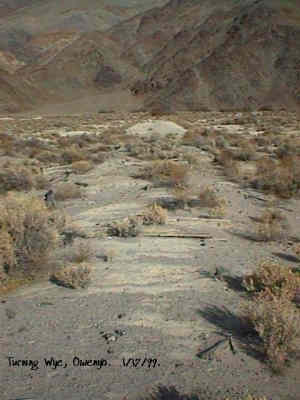 Standard gauge turning wye, view east. 1/17/99. Courtesy David A. Wright 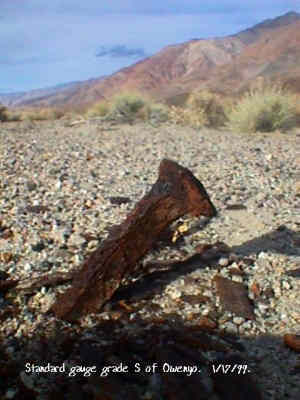 Sighting north along the standard gauge Southern Pacific "Jawbone" Branch north toward Courtesy David A. Wright  Sighting northeast along the standard gauge line into Owenyo, the "downtown" area marked by the salt cedar trees in the left background. The grade will soon swing into the area of the transfer trestle, then curve to a north-south alignment for the final leg into Owenyo. 1/17/99. Courtesy David A. Wright 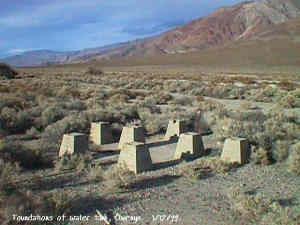 Foundations of the water tank. 1/17/99. Courtesy David A. Wright 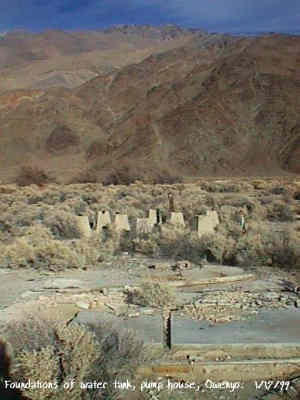 Foundations of water pumphouse (foreground) and water tank. 1/17/99. Courtesy David A. Wright 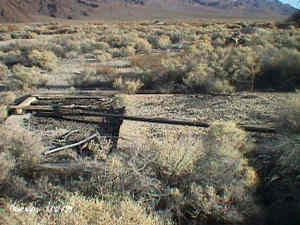 Foundations along the standard gauge turning wye. 1/17/99. Courtesy David A. Wright Owenyo Courtesy David A. Wright Owenyo Courtesy David A. Wright 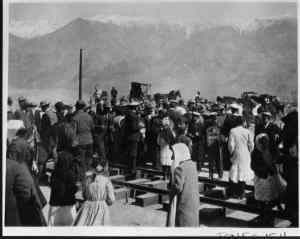 Owenyo, CA in 1911 during the ceremony of the joining of the two branches of the Southern Pacific -- the standard gauge "Jawbone" (Owenyo) Branch and the narrow gauge Owens Valley Branch. David A. Wright collection, courtesy of Eastern California Museum. 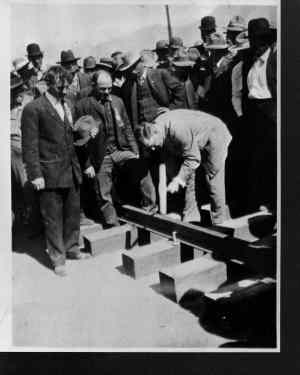 Owenyo, CA in 1911 during the ceremony of the joining of the two branches of the Southern Pacific -- the standard gauge "Jawbone" (Owenyo) Branch and the narrow gauge Owens Valley Branch. David A. Wright collection, courtesy of Eastern California Museum. 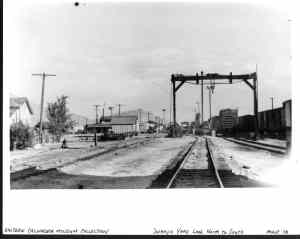 Owenyo, CA. View south through the yards. David A. Wright collection, courtesy of Eastern California Museum. |
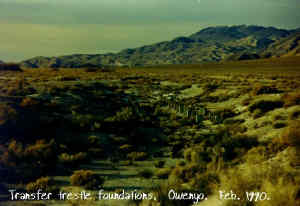 View north across Owenyo from transfer trestle on the south end of the yard complex. The transfer trestle accommodated transfer or ores or other materials to be placed from narrow gauge gondolas to standard gauge gondolas for export from Owens Valley. The narrow gauge gondolas were pushed from the north up onto the trestle (cars coming in towards camera), standard gauge gondolas were spotted underneath and accessed the trestle from the south. February 1990. Courtesy David A. Wright 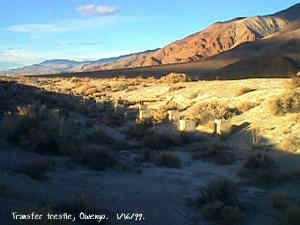 Transfer trestle, 1/16/99. Courtesy David A. Wright 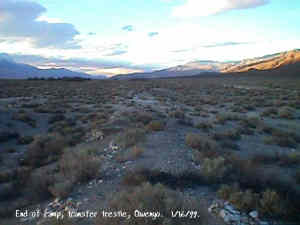 View north from the end of the narrow gauge ramp that allowed narrow gauge cars to be placed upon the transfer trestle. The narrow gauge mainline is located to the left of this ramp, the standard gauge Southern Pacific "Jawbone" Branch mainline is located to the right of the photo. The trees in the background locate the general area of "downtown" Owenyo. 1/16/99. Courtesy David A. Wright  Foundation of Owenyo Station, view north. 1/16/99. Courtesy David A. Wright 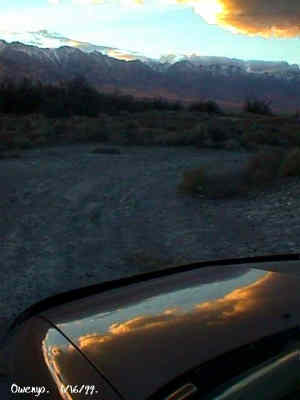 Owenyo, looking northwest to the Sierra Nevada. 1/16/99. Courtesy David A. Wright 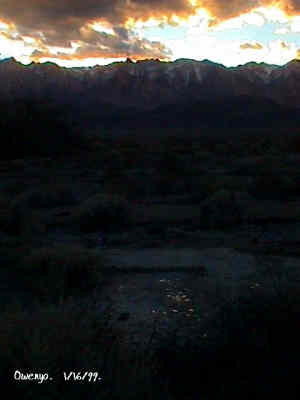 Sunset over the Sierra Nevada from Owenyo Station. 1/16/99. Courtesy David A. Wright 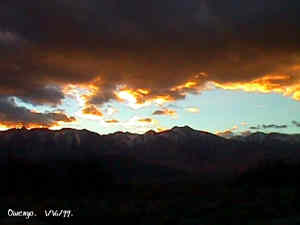 Sunset over the Sierra Nevada from Owenyo Station. 1/16/99. Courtesy David A. Wright 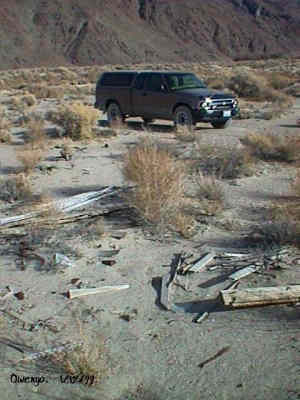 Much lumber and trash locate the community area of Owenyo. 1/17/99. Courtesy David A. Wright 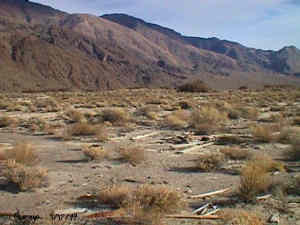 Much lumber and trash locate the community area of Owenyo. 1/17/99. Courtesy David A. Wright  Standard gauge turning wye, view east. North and south legs of the wye can be seen in background. 1/17/99. Courtesy David A. Wright 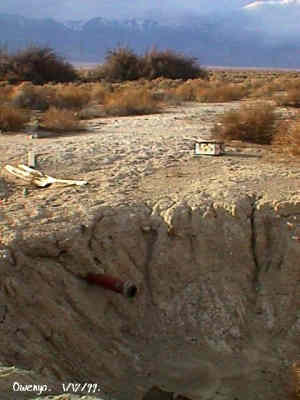 Area where water and oil tanks were located. 1/17/99. Courtesy David A Wright 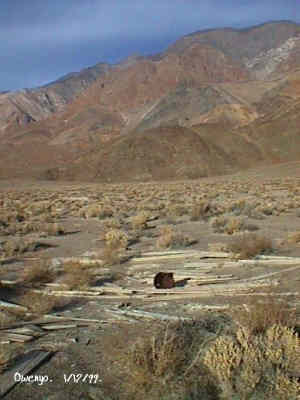 Owenyo, ruins on east side of Owenyo Road. 1/17/99. Courtesy David A. Wright Owenyo Courtesy David A. Wright Owenyo Courtesy David A. Wright 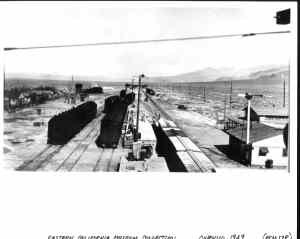 Owenyo, CA, view north along the Southern Pacific Owens Valley Branch narrow gauge line. Standar gauge tracks are to the left, the narrow gauge to the right. David A. Wright collection, courtesy of Eastern California Museum. 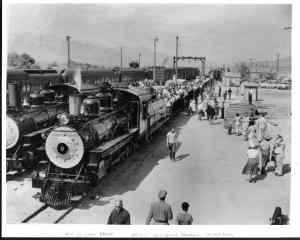 Owenyo, CA during a railfan activity during the 1950's. The difference in scale between the two gauges can be seen in that the Pullman cars of the standard gauge Owenyo Branch coming in from Mojave, CA, are larger than the narrow gauge locomotives. David A. Wright collection, courtesy of Eastern California Museum. 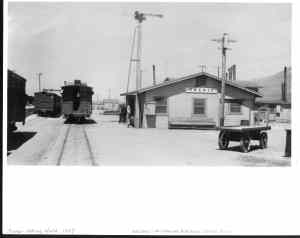 Owenyo, CA. Note the use of the semiphore signal, still in use long after Southern Pacific had gone to signal lights on the remainder of their branches. David A. Wright collection, courtesy of Eastern California Museum. |
|
|